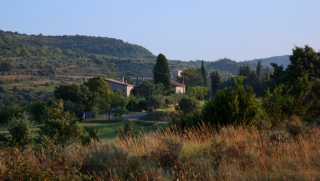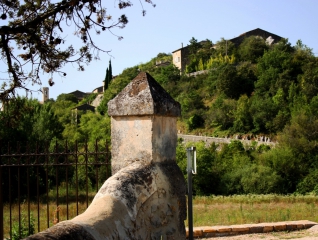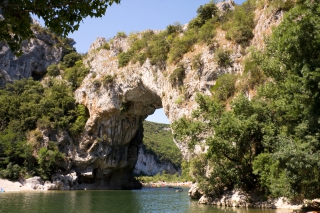The villa is located near Vallon Pont d’Arc in the municipality of Lagorce. There was a lot to report on the River Ardèche, the leisure facilities of the Ardèche department and the immediate environment.
There are water sports on the Ardèche, speleology, around the Ardèche, prehistoric sites in the valley of the Ardèche and the l’Ibie, archaeological sites, bike and hiking trails, fishing opportunities, the Ardèche for gourmets, historic sites, castles and forts the diverse flora and fauna, cultural events or just relax around the Ardèche. That can not be all listed here. Therefore, only a brief description of the most important landmarks around “Chez Marius”.
The Ardèche
The Ardèche flows through the regions of Rhône-Alpes and Languedoc-Roussillon. The source is located in the Natural Park of Monts d’Ardèche in the field of the municipality of Astet. In the lower reaches is the 30 km long spectacular Canyon “Gorges de l’Ardèche”, which is far beyond the borders of France’s famous. This Canyon is located between the towns of Vallon Pont d’Arc and Saint Martin d’Ardèche. From the road at the edge of the canyon (Corniche) one has spectacular views over the Canyon and river. After 125 km, the Ardèche flows near Pont Saint Esprit in the Rhone.
Particularly well known is the Ardeche to canoe and kayak athletes. The river is holding al lot of water in spring, so the rapids swell and become very demanding. In the summer, the amount of water goes down and it is perfect for family trips by canoe. The banks, which only can be accessed from the water, have nice shady spots for a picnic.
In November, the spectacular “Marathon International des Gorges de l’Ardèche” is held, with up to 1,500 participants.
Lagorce
“Chez Marius” is located in the municipality of Lagorce. Lagorce has only a little more than 700 inhabitants, but these are spread over more than 7000 hectares thus Lagorce is geographically the largest municipality in the department of Ardèche. The small clusters of houses extending between Vallon Pont d’Arc and Ruoms, between Ardèche and L’Ibie.??
Lagorce benefits from a high number of hours of sunshine and a pleasant Mediterranean climate. The calcareous soil promotes the formation of hills, caves and grottos. The Vegation is typical for the Mediterranean, with pines, oaks, wild juniper, olive trees and many plants and herbs of the garrigue. ??In the wide area contains scattered around the vineyards and olive groves.?? Among other products, excellent wine is produced there, which is classified as AOC / Côtes du Vivarais and every year is considered in the wine competitions with medals. Exciting is the museum for sericulture (Ma Magnanerie), which was traditionally practiced here.
The village Lagorce is located on a rock. The main road winds between the stone houses, the narrow streets on the hill above is better to be explored on foot. In the Epicerie there is everything you need: baguette, homemade cakes, newspaper, milk, cheese, salami and ham, wine (all from local producers) and also batteries and toys.
Vallon Pont d’Arc
Vallon-Pont d’Arc is a typical Provencal village with many stone buildings and sunlit squares with cafes surrounded by plane trees. The village is located above the Ardèche. Typical regional products can be bought everywhere in the city. In the small pedestrian zone there is a lot to discover for all ages.
Many traders build up their stalls for the great Provencal market on Thursday, it attracts people from far and wide to Vallon.
The place is known above all by the 60 meter high stone Pont d’Arc, who was elected for the place name as an additive. On the outskirts of Ibie joins the Ardèche.
Ruoms, Balazuc, Vogue
Many picturesque villages are located very close to “Chez Marius”. For shopping, you can visit Ruoms. Besides the city and the market on Friday there is a large supermarket – the Super U – at the roundabout to Vallon. On the other side of the roundabout is the “Cave Cooperative”. Who wants to taste good wine, that is the right place.
The towns Balazuc and Vogue, with their beautiful houses on the mountainside, are always worth a visit.
The Chateau of Vogue accomodates usually featured exhibitions.
Chauvet Cave
In December 1994, the Cave Chauvet was discovered on the territory of Vallon Pont d’Arc of Christian Hillaire, Eliette Brunel Deschamps and Jean-Marie Chauvet, the latter named after Chauvet cave (Grotte Chauvet). In the cave were the world’s oldest known cave paintings and cave drawings found. There were over 400 murals. The oldest have been dated to 32000-35000 years ago. The cave is a World Heritage site by the Unesco. In order to protect the paintings, it is not open to the public.
On the hills, not far from our house, the cave is now reconstructed. The “Caverne du Pont d’Arc” is an unforgettable time travel to our ancestors 36.000 years ago.
If you are planning your visit in the Caverne, please make an online reservation before. The site is very popular, so sometimes it is not possible to visit it without reservation. Here you can make your online reservation: http://www.cavernedupontdarc.fr/reservez-en-ligne/
The Cevennes
The Cevennes extend over the Ardeche, Lozere, Gard, Herault and Haute-Loire. The highest mountain of the Cevennes, the Mont Lozère with 1699 meters, Mont Aigoual (1567m) is the most famous peaks of the Cevennes. The Cevennes consist mainly of mountain ranges and extremely dry plateaus, which are cut into deep canyons of some of the major rivers of the Languedoc.
UNESCO has declared in June 2011, more than 3000 square kilometers of the Cevennes between cities Ganges and Millau, Mende and Lodève as World Heritage. There are also around 100 square kilometers buffer zone around the actual world heritage area.The area largely coincides with several protected areas that existed for some time: the Cevennes National Park (since 1970), the UNESCO Biosphere Reservation (since 1985) and the Regional Natural Park of the Grandes Causses (since 1995).
Recognition as a World Heritage Site due in part to the fact that here the migratory sheep (transhumance) is still practiced like ages ago. The UNESCO justify its decision as follows: “The landscape of plateaus (limestone plateaus) have been formed in three millennia of pastoralism.” They represent a cultural tradition, “which is based on traditional social structures and local sheep breeds and is reflected in the landscape structure, especially in the type of houses, buildings, fields, water management, the ways of the cattle drive (drailles) and the local commons “.
These are the local goats from Les Riailles.
There is still sooo much to report. But honestly: Underneath the blue sky of Provence to discover the area itself is much more fun!






















